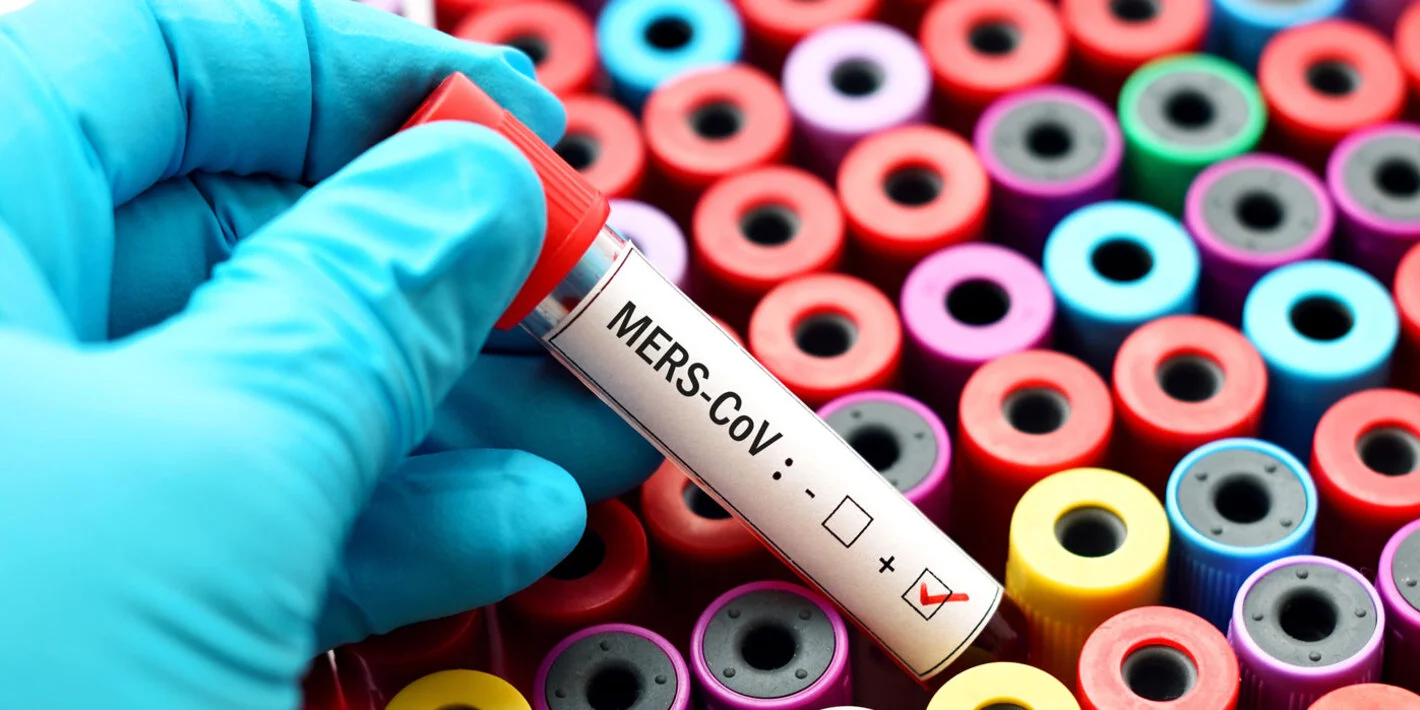MERS

Copyright infringement not intended
Context: The World Health Organisation (WHO) confirmed a case of Middle East Respiratory Syndrome Coronavirus (MERS-CoV) in Abu Dhabi. Health officials had already traced and checked 108 people who had come into contact with the infected man, but no secondary infections had been reported at that time.
Details
- MERS-CoV is a viral respiratory illness that can be severe and potentially fatal in some cases. The virus is known to spread from dromedary camels to humans, and occasionally from human to human through close contact. However, in this particular case, there were no signs that the man had come into contact with dromedary camels, which are known to be a source of the disease.
Origin
- The Middle East Respiratory Syndrome Coronavirus (MERS-CoV) is a viral respiratory disease that was first identified in Saudi Arabia in 2012. It is caused by a zoonotic virus, meaning it is transmitted between animals and people, mainly through direct or indirect contact with infected dromedary camels.
- MERS-CoV belongs to the same family of viruses that cause the common cold, Severe Acute Respiratory Syndrome (SARS) and Coronavirus Disease-2019 (COVID-19).
- Since its emergence, MERS-CoV has spread to more than 27 countries and caused over 2500 confirmed cases and 858 deaths, according to the World Health Organization (WHO). Most of the cases have occurred in the Middle East, especially in Saudi Arabia, but there have also been outbreaks in other regions, such as South Korea in 2015 and the United Arab Emirates in 2020.
- The case fatality rate of MERS-CoV is estimated to be around 35%, but this may be an overestimate as mild or asymptomatic cases may be missed by surveillance systems.
Symptoms
- MERS-CoV can cause a range of symptoms, which can vary from mild to severe. Common symptoms include fever, cough, shortness of breath, and respiratory difficulties.
- In severe cases, the virus can lead to pneumonia, acute respiratory distress syndrome (ARDS), and even death.
Challenges for public health authorities and Healthcare systems
Limited Treatment Options
- One of the main challenges of MERS-CoV is the lack of specific antiviral treatments. Currently, there is no vaccine or approved therapy for MERS-CoV, and the treatment is mainly supportive and symptomatic. This makes it difficult to manage severe cases effectively and reduce mortality. Therefore, there is an urgent need for research and development of new drugs and vaccines for MERS-CoV.
Human-to-Human Transmission
- While the primary source of infection is believed to be camels, MERS-CoV can also spread from person to person in close-contact settings such as healthcare facilities, households, or workplaces. This presents challenges for the containment and prevention of outbreaks, especially in resource-limited settings where infection control measures may be inadequate. Therefore, there is a need for strengthening surveillance and contact tracing, as well as implementing appropriate infection prevention and control practices.
Asymptomatic Carriers
- Some individuals infected with MERS-CoV may exhibit mild or no symptoms, making it difficult to identify and isolate cases promptly. This may result in undetected transmission and an increased risk of exposure to others. Therefore, there is a need for enhancing laboratory testing and diagnostic capacity, as well as raise awareness and educate the public about the signs and symptoms of MERS-CoV.
Global Spread
- International travel and movement can lead to the virus spreading to new regions, necessitating international cooperation in surveillance and response. Therefore, there is a need for improving global health security and preparedness, as well as sharing information and best practices among countries and regions affected by or at risk of MERS-CoV.
A comprehensive strategy to address the challenges
Surveillance and Early Detection
- Enhanced surveillance and early detection of cases are crucial to contain outbreaks promptly. This includes strengthening laboratory capacity, improving case definitions and reporting systems, conducting active case finding and contact tracing, and sharing data and samples with WHO and other partners.
Infection Control Measures
- Strict infection control measures in healthcare facilities can prevent the spread of the virus among patients and healthcare workers. This includes implementing standard precautions, such as hand hygiene and personal protective equipment, as well as additional precautions for suspected or confirmed cases, such as isolation and cohorts. Healthcare workers should also be trained and supervised in infection prevention and control practices.
Public Awareness and Education
- Raising awareness about MERS-CoV, its symptoms, and preventive measures can help reduce transmission risks. This includes providing accurate and timely information to the public, especially travellers and pilgrims to the Middle East, through various media channels and platforms. It also involves educating high-risk groups, such as people with underlying medical conditions, camel workers, and animal owners, on how to protect themselves and their animals from infection.
Research and Vaccine Development
- Investment in research to better understand the virus and develop potential vaccines or treatments is essential. This includes conducting epidemiological, virological, immunological, and clinical studies to elucidate the source, mode of transmission, risk factors, pathogenesis, and immune response of MERS-CoV. It also involves supporting the development and evaluation of candidate vaccines or therapeutics in preclinical and clinical trials.
International Collaboration
- Given the global nature of travel and trade, international cooperation and information sharing are vital to respond effectively to MERS-CoV outbreaks. This includes adhering to the International Health Regulations (2005), which require countries to notify WHO of any event that may constitute a public health emergency of international concern. It also involves participating in global networks and initiatives, such as the Global Outbreak Alert and Response Network (GOARN), the Middle East Respiratory Syndrome Coronavirus Research Group (MERG), and the Coalition for Epidemic Preparedness Innovations (CEPI).
One Health Approach
- Given the zoonotic origin of MERS-CoV, a "One Health" approach that involves collaboration between human health, animal health, and environmental sectors is necessary for surveillance and control. This includes conducting joint investigations and interventions at the human-animal interface, enhancing animal health systems and biosecurity measures, promoting responsible animal husbandry practices, and addressing environmental factors that may facilitate viral spillover or amplification.
Conclusion
- Middle East Respiratory Syndrome Coronavirus (MERS-CoV) is a viral respiratory illness that can cause a range of symptoms, including fever, cough, and respiratory difficulties. Some of the challenges include limited treatment options, human-to-human transmission, asymptomatic carriers, and the potential for global spread through international travel. To address these challenges, a comprehensive approach is required, including enhanced surveillance and early detection, strict infection control measures, public awareness and education, research and vaccine development, international collaboration, and adopting a "One Health" approach that involves cooperation between human health, animal health, and environmental sectors.
Must Read Articles:
‘ONE HEALTH’ APPROACH: https://www.iasgyan.in/daily-current-affairs/one-health-approach-37
|
PRACTICE QUESTION Q. Consider the following statements in the context of the Middle East Respiratory Syndrome Coronavirus (MERS-CoV) 1. Camels act as an intermediate host for the virus, and direct or indirect contact with infected camels is a known risk factor for human infection. 2. Common symptoms of MERS-CoV infection include fever, cough, shortness of breath, and muscle pain. In severe cases, the virus can lead to pneumonia and respiratory distress. Which of the following Statement is/are correct? A) 1 only B) 2 only C) Both 1 and 2 D) Neither 1 nor 2 Answer: C Explanation: MERS-CoV is a zoonotic virus, meaning it can be transmitted from animals to humans, and camels are known to be an important reservoir and source of the virus. Human cases of MERS-CoV infection have been linked to contact with infected camels or their bodily fluids. Symptoms of MERS-CoV infection in humans can range from mild to severe, with respiratory symptoms being the most common presentation. In severe cases, it can progress to pneumonia and acute respiratory distress syndrome (ARDS). |




.jpg)
1.png)
